MSI’s GeForce N470GTX & GTX 470 SLI
by Ryan Smith on July 30, 2010 1:28 PM ESTMSI N470GTX: Power, Temperature, Noise, & Overclocking
As we’ve discussed in previous articles, with the Fermi family GPUs no longer are binned for operation at a single voltage, rather they’re assigned whatever level of voltage is required for them to operate at the desired clockspeeds. As a result any two otherwise identical cards can have a different core voltage, which muddies the situation some. This is particularly the case for our GTX 470 cards, as our N470GTX has a significantly different voltage than our reference GTX 470 sample.
|
GeForce GTX 400 Series Voltage |
||||
| Ref GTX 480 | Ref GTX 470 | MSI N470GTX | Ref GTX 460 768MB | Ref GTX 460 1GB |
|
0.987v
|
0.9625v
|
1.025v
|
0.987v
|
1.025v
|
While our reference GTX 470 has a VID of 0.9625v, our N470GTX sample has a VID of 1.025v, a 0.0625v difference. Bear in mind that this comes down to the luck of the draw, and the situation could easily have been reversed. In any case this is the largest difference we’ve seen among any of the GTX 400 series cards we’ve tested, so we’ve gone ahead and recorded separate load numbers for our N470GTX sample to highlight the power/temperature/noise range that exists within a single product line.
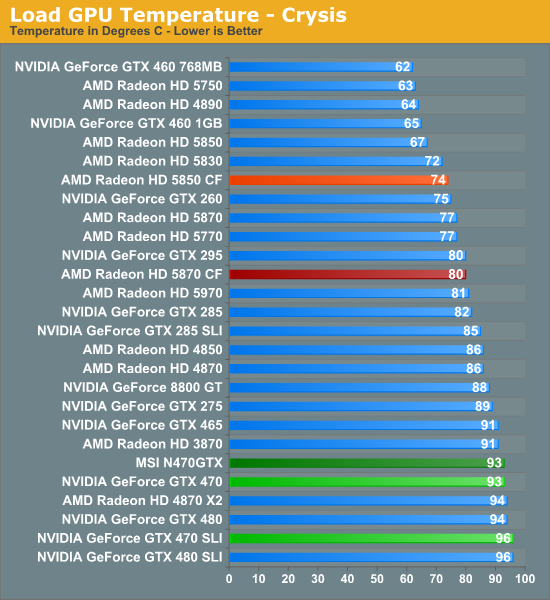
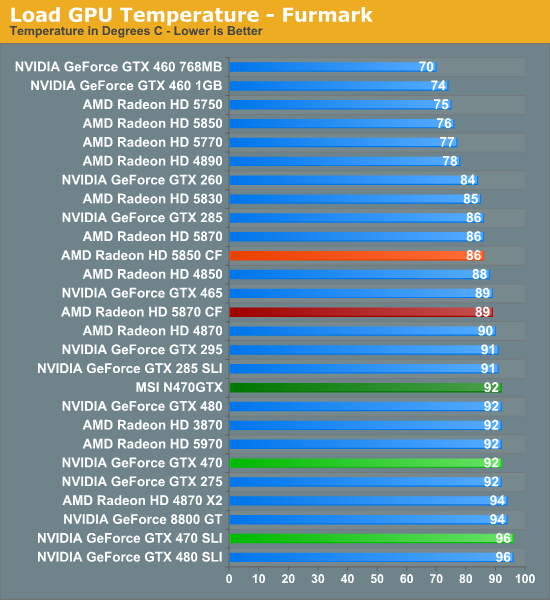
Quickly looking at load temperatures, in practice these don’t vary due to the fact that the cooler is programed to keep the card below a predetermined temperature and will simply ramp up to a higher speed on a hotter card.
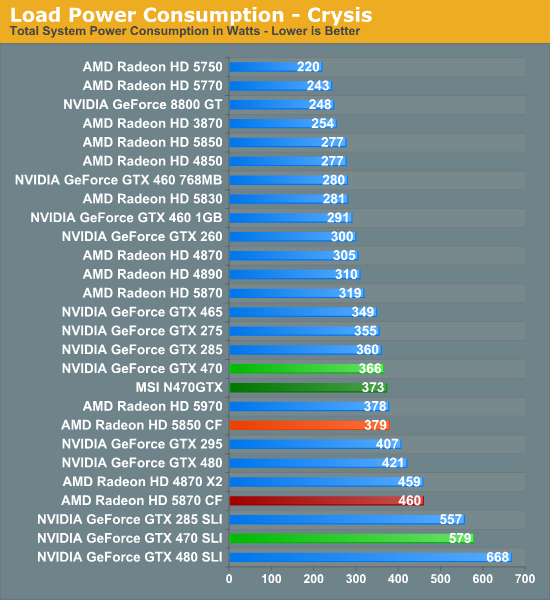
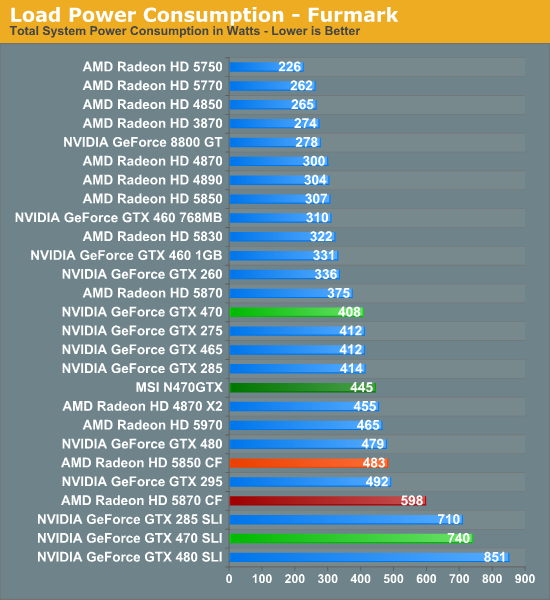
This brings us to power consumption where the difference in VID makes itself much more apparent. With all things being held equal, under Crysis our N470GTX sample ends up consuming 7W more than our reference sample GTX 470. However under Furmark this becomes a 37W difference, showcasing just how wide of a variance the use of multiple VIDs can lead to in a single product. Ultimately for most games such a large VID isn’t going to result in more than a few watts’ difference in power consumption, but under extreme loads having a card with a lower VID GPU can have its advantages.
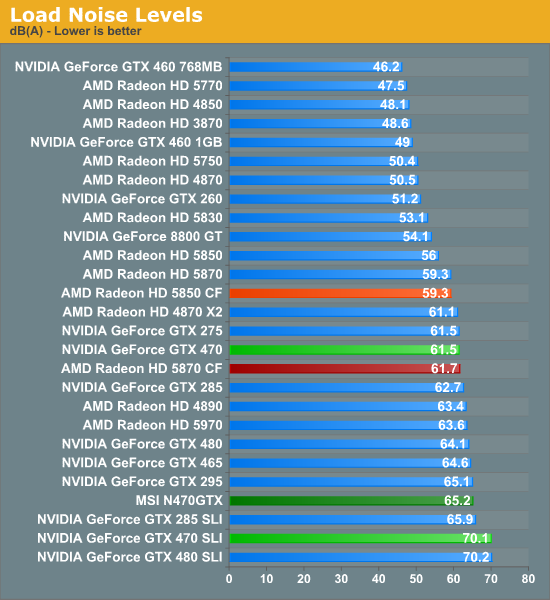
As we started before, the cooler on the GTX 470 targets a specific temperature, varying the fan speed to match it. With the higher VID and greater power consumption of our N470GTX sample, this means the card ends up being a good 3.7dB louder under Furmark than our reference sample, thanks to the higher power draw (and hence heat dissipation) of the card. Note that this is a worst-case scenario though, as under most games there’s a much smaller power draw difference between cards of different VIDs, and as a result the difference in load noise is also minimal.
Overclocking
With MSI’s Afterburner software it’s possible to increase the core voltage on the N470GTX up to 1.0875v, 0.0625v above the stock voltage of our sample card. Although by no means a small difference, neither is it more than the reference GTX 470 cooler can handle, so in a well-ventilated case we’ve found that it’s safe to go all the way to 1.0875v.
| Stock Clock | Max Overclock | Stock Voltage | Overclocked Voltage | |
| MSI N470GTX | 675MHz | 790MHz | 1.025v | 1.087v |
With our N470GTX cranked up to 1.0875v, we were able to increase the core clock to 790MHz (which also gives us a 1580MHz shader clock), a 183MHz (30%) increase in the core clock speed. Anything beyond 790MHz would result in artifacting.
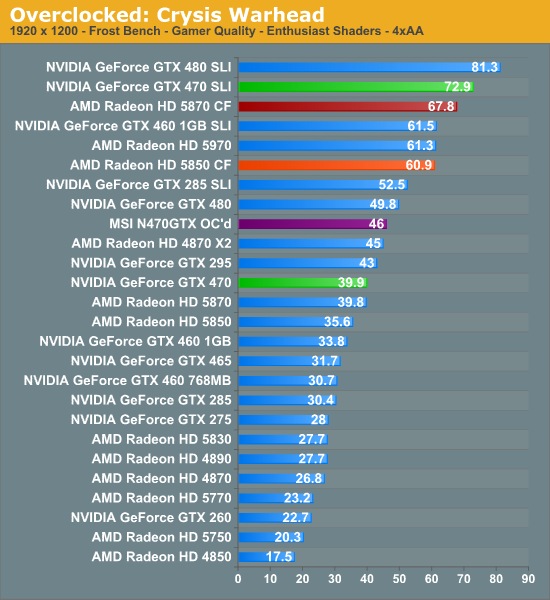

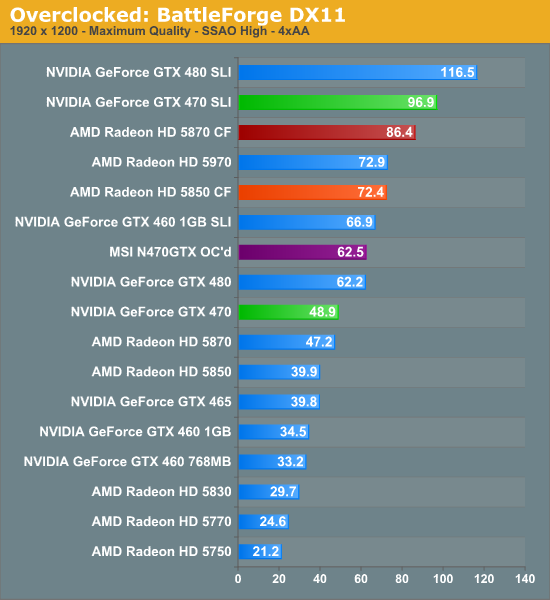
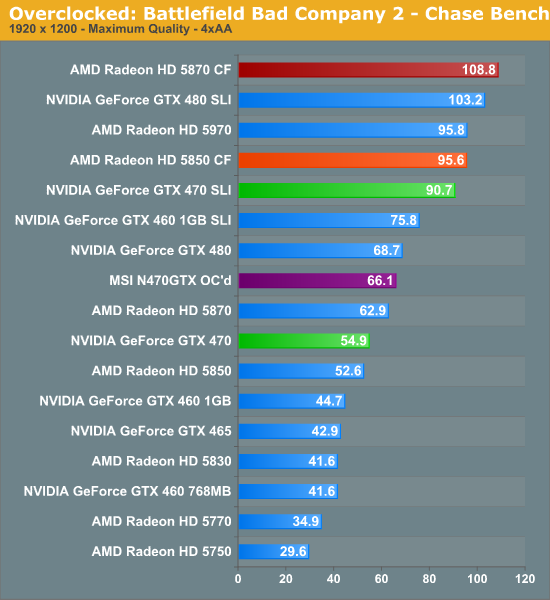
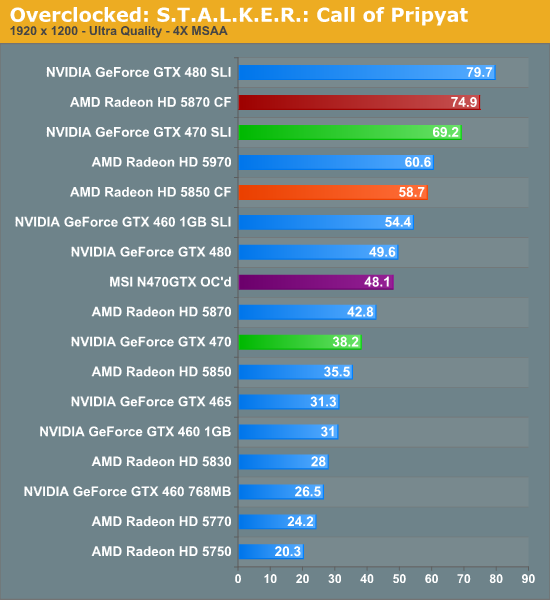
Overclocking alone isn’t enough to push the N470GTX to GTX 480 levels, but it’s enough to come close much of the time. In cases where the GTX 480 already has a solid lead over its competition the overclocked N470GTX is often right behind it – in this case this means the overclocked N470GTX manages to consistently beat the Radeon 5870, something a stock-clocked GTX 470 cannot do.
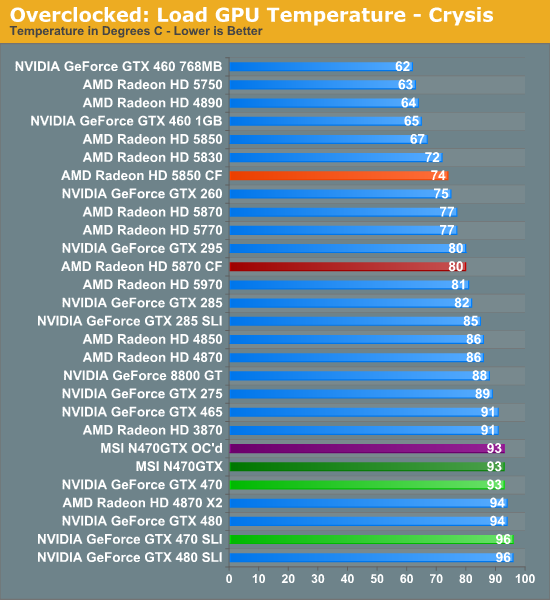
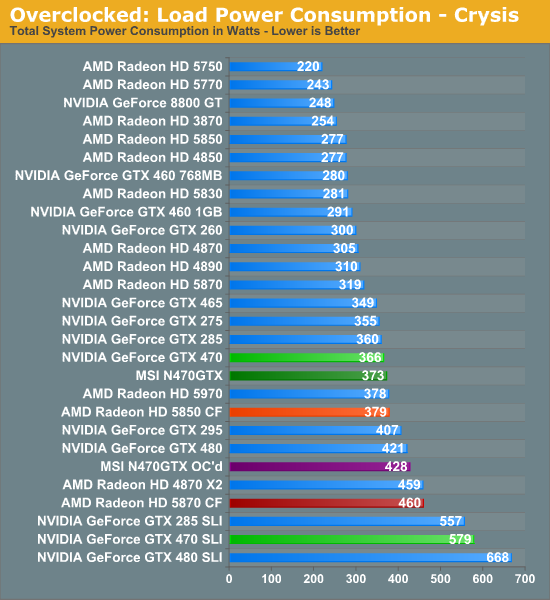
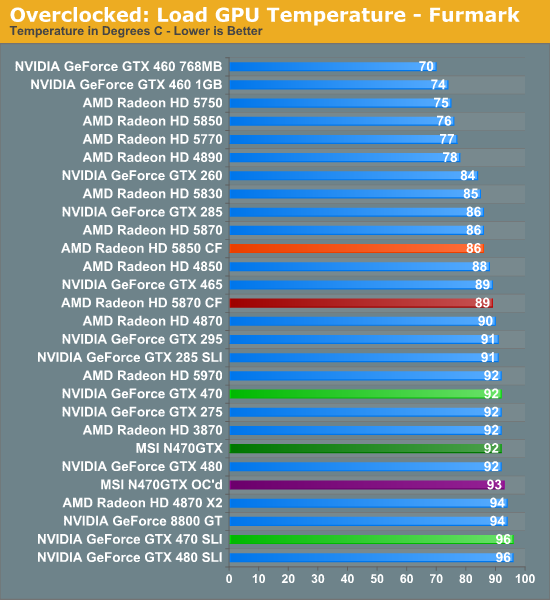
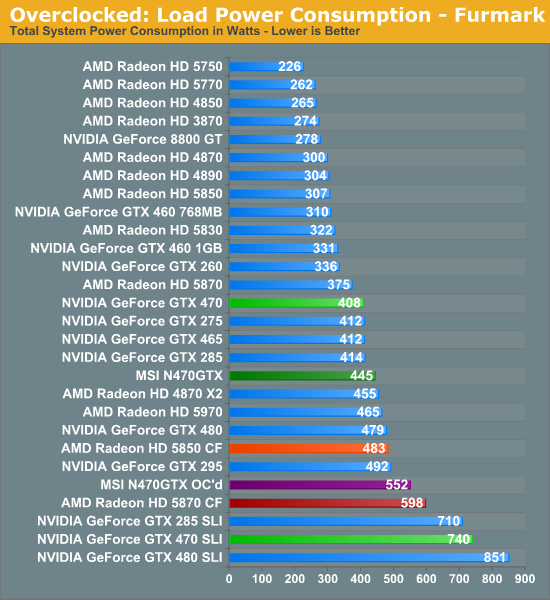
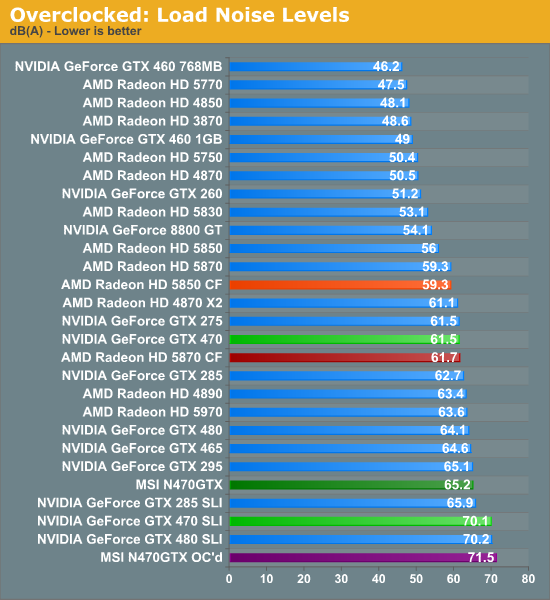
But due to the use of overvolting, that extra performance means there comes a time to pay the piper. While our temperatures hold consistent the additional voltage directly leads to additional power draw and higher fan speeds. The overclocked N470GTX can approach GTX 480 performance, but it exceeds the GTX 480 in these metrics. In terms of load noise the overclocked N470GTX is pushing just shy of 100% fan speed, making it the loudest card among our test suite. Similarly, load power consumption under both Crysis and Furmark exceeds any of our stock-clocked single-GPU cards.
Ultimately overclocking the N470GTX provides a very generous performance boost, but to make use of it you need to put up with an incredible amount of heat and noise, so it’s not by any means an easy tradeoff.










41 Comments
View All Comments
afkrotch - Monday, August 2, 2010 - link
Let's not forget that these same cards end up with different firmware and get called Quadros, FireGL, or whatever else.Solidstate89 - Friday, July 30, 2010 - link
First time poster in the Anandtech comments, just want to first off say that this is a great site and I've been reading it for years. By far the most unbiased and intelligently written tech site.However regarding this MSI 470; I assume you did a review on this because of its claims of using superior hardware like the chokes you mentioned. However I was wondering why you didn't do it on the MSI GTX 470 Twin Forzr II that uses MSI's special dual-fan cooling system. I've been looking at the card since it was first announced I've yet to find one site that has done a review on it. The closest I found was a review for the 465 Twin Frozr II on Guru3D, but I wanted to see the temps for the 470. I have a feeling you might even pleasantly surprised by the temps of a GF100 card if they do indeed fall in line with what the 465 was getting.
Perhaps you could do it as part of a special Non-reference design article like you did with the 5870s not too long ago. I'm not even sure if you read these comments, but I just thought I'd give input for something that I'd like to see and I'm sure many others might find interesting as well, especially if you were to do a comparison piece.
Patrick Wolf - Friday, July 30, 2010 - link
That would be cool if they tested all card's with special coolers. But I don't think they chose the MSI card. They needed an extra 470 for the article and MSI was the one that accepted the requet.Ryan Smith - Friday, July 30, 2010 - link
That's pretty much the correct answer. We needed a reference-style GTX 470 and MSI obliged our request. We review a lot of custom cards, but you'll find that we are unable to review every last custom card due to the fact that there are a ton of them.edi_opteron - Friday, July 30, 2010 - link
AMD sold 16 Million 5000 series during these 6months while nVidia was Silent! I'm really interested in this amazing performance...really....It's very interesting for me to see a 470GTX beats AMD's top-end HD5870! but let's be honest after six months nVidia must release sth like fermi to at least compete AMD's VGAs...but don't go so far, AMD's Southern Islands will be in stores after few months and i don't think that nVidia could reply AMD except with it's fermi ! and i advise you guys to go for AMD's 6000 series if you can wait for some days!ggathagan - Saturday, July 31, 2010 - link
... and when AMD releases the 6000 series, someone else will same the same thing regarding Nvidia's next generation of GPU.Most people are better off buying the best they can get for the money they want to spend at the time they want to buy it.
Otherwise, it turns into a never-ending waiting game.
billdcat4 - Friday, July 30, 2010 - link
Newegg has a promo code for the MSI GTX 470 cutting 10% off of its original priceEMCYVNV39
This brings the card to $269 before $20 MIR
politbureau - Friday, July 30, 2010 - link
Still somewhat disappointed not to see Vantage numbers in Anand GPU reviews. This would be an easily repeatable benchmark for home users that doesn't involve strictly game benchmarks. I surmise the mindset is that Vantage is purely a benchmark or WR tool, but then I'd question why there has been such a recent push on benchmarking hardware (ie "Four Flagship X58 Motherboards Reviewed").This is pretty much the only reason I've switched to reading GPU reviews from Guru3D, as I much prefer the tone and clarity here at Anand.
$0.02
Ryan Smith - Friday, July 30, 2010 - link
The short answer is that we use different tools for different types of articles.Synthetic benchmarks can be very handy for isolating specific aspects of a piece of hardware's performance. For example if we want to do texturing tests then Vantage is the de-facto way to go. However when it comes to overall performance, synthetic benchmarks do not tell you how a game will play on the card because they are in fact not a game - they're synthetic.
More specifically, AMD and NVIDIA put a lot of effort in to their drivers to optimize the performance of their products on games and benchmarks alike. However they don't have the resources to work on every last game, and a large factor in deciding what to spend their limited time on is to see what review sites are using. Optimizing their drivers for commonly benchmarked games can directly impact their sales by making the performance of their cards improve in the games that ultimately impact the recommendations of editors. Or to put this another way: it's to their benefit to optimize their drivers to make their cards look good in reviews.
It goes without saying that we would prefer that every game is appropriately optimized, but this isn't realistic. So we have to pick our games based on what we think is going to be the most relevant to our readers while taking in to consideration that we're indirectly affecting what games get optimized.
So what does this have to do with 3DMark? As we previously established, 3DMark is synthetic - it isn't a game. If GPU manufacturers focus on improving 3DMark performance, then they're doing so at the detriment of real games. For a GPU review we do not use 3DMark as part of our general benchmark suite because it would only tell you how well a card performs on 3DMark, and it would be a signal to GPU makers to optimize for synthetic benchmark. People buy video cards to play games and run GPGPU applications, not to run 3DMark.
As for other types reviews, this is not an issue. In other articles the GPU is held constant, so we're using these tools purely as a diagnostic tool rather than to evaluate a GPU. For GPU makers there's nothing to "win" in those reviews, and motherboard makers they can't optimize for 3DMark. It's a problem that's distinctly GPU-only.
Quidam67 - Saturday, July 31, 2010 - link
Your rationale seems well thought out, but I'm not entirely buying it. Calling 3DMark "synthetic" is in my opinion semantics. It's no more synthetic than a game were you to compare it to another game using a different 3D engine. If anything, it's more well rounded as it is specifically designed to test 3D performance under a number of different metrics. Also, 3D Mark is an evolving product. It's not like they only ever wrote one version. Vantage is just the latest version, designed to keep the metrics contemporary with the latest hardware; drivers and API's. Also, you seem to contend that people who play games therefore aren't interested in running 3D mark. I've been a gamer since the Commodore Vic 20 and I always run 3D mark whenever I get a new card. Yes, I know it's not going to tell me everything I need to know about the performance of the card, but it is one piece of the jigsaw puzzle, besides of which, it is a fun and easy way to gauge impacts and stability especially when overclocking your system (not just the GPU). I for one would appreciate seeing published results as part of a GPU review.Lastly, while it is probably almost certainly true that drivers are optimised with 3D Mark in mind, it is hard to believe they are optimised in such a way as to offer zero percent benefit to any other application other than 3D Mark. I mean, 3D Mark is after all using a common set of API's. From what I've observed, game-specific driver optimisations (ATI and nVidia) typically offer gains only in the single % digit range. For example it's not as if Crysis has been "mastered" by driver optimisations -a poorly programmed game can't be fixed by improving drivers (just the same as a good hair-cut doesn't guarantee you are going to get laid, at least it never worked for me)
In my view, Anandtech should reconsider its position not to include this so-called synthetic bench-mark, as I sincerely think you guys are making way too much out of it.